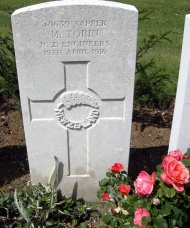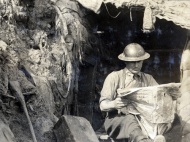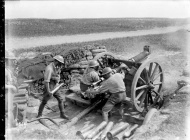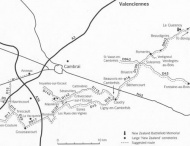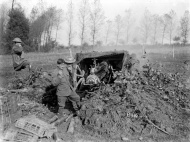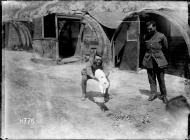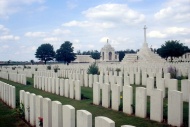Events In History
-
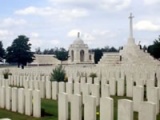 12 October 1917NZ's ‘blackest day’ at Passchendaele
12 October 1917NZ's ‘blackest day’ at PasschendaeleIn terms of lives lost in a single day, this was the greatest disaster in New Zealand's modern history. The failed assault on Passchendaele in Belgium took the lives of 45 officers and 800 men, and left more than 2700 wounded. Read more...
Articles
New Zealand and Le Quesnoy

It was the New Zealand Division's final action of the First World War. On 4 November 1918, just a week before the Armistice was signed, New Zealand troops stormed the walled French town of Le Quesnoy. The 90 men killed were among the last of the 12,483 who fell on the Western Front.
-
Page 2 – The liberation of Le Quesnoy
The capture of the French town of Le Quesnoy by the New Zealand Division on 4 November 1918 has special significance in New Zealand's military history.
-
Page 3 – Visiting Le Quesnoy
Just 4 kilometres east of Beaudignies in northern France is Le Quesnoy. This town was in German hands for almost all of the First World War, from August 1914, until the New
-
Page 4 – Battle accounts, Lieutenant Averill
Leslie Cecil Lloyd Averill is best remembered for his exploits during the liberation of Le Quesnoy on 4 November 1918.
-
Page 5 – Battle accounts, Private Nimmo
Captain James Matheson Nimmo joined 3rd Battalion, 3rd New Zealand (Rifle) Brigade on 27 September 1918.
Battle of the Somme

A truly nightmarish world greeted the New Zealand Division when it joined the Battle of the Somme in mid-September 1916. Fifteen thousand men of the Division went into action. Nearly 6000 were wounded and 2000 lost their lives. More than half the New Zealand Somme dead have no known grave.
-
Page 2 – Overview
'Somme. The whole history of the world cannot contain a more gruesome word.' This is how one German officer described the Battle of the Somme in 1916.
-
Page 3 – New Zealand's Somme experience
It was on the Somme that the largest number of New Zealanders were killed or wounded during the First World War.
-
Page 4 – Men and machines
By the time of the Somme offensive of 1916, the Great War was shaped by artillery.
-
Page 5 – New Zealand artillery on the Somme
The big guns roared into life along the New Zealand Division's line on the Somme in support of a major attack on 15 September 1916.
The Arras tunnels

During the First World War the men of the New Zealand Tunnelling Company, many of them hardbitten West Coast miners, helped create a vast network of military tunnels under the French town of Arras.
-
Page 2 – The New Zealand Tunnelling Company
With both the Allies and the Germans trying to tunnel under each other's lines to lay mines, the New Zealand Tunnelling Company's experience was invaluable.
British Empire

Key information and statistics about countries who fought as part of the British Empire during the First World War
-
Page 3 – Commonwealth of Australia
Key information and statistics about the Commonwealth of Australia during the First World War
-
Page 4 – Dominion of Canada
Key information and statistics about Canada during the First World War
-
Page 5 – British India
Facts and statistics about India during the First World War
-
Page 6 – Dominion of Newfoundland
Key information and statistics about the Dominion of Newfoundland during the First World War
Pacific Islanders in the NZEF

Cook Islanders, Niueans, Fijians and Gilbert Islanders all took their place in the ranks of the New Zealand Expeditionary Force during the First World War. As well as the dangers of war, Pacific soldiers faced language difficulties, an unfamiliar army diet and European diseases.
- Page 2 - Niueans and Cook IslandersInformation about Niuean and Cook Island soldiers who were part of the 3rd Maori Contingent of Reinforcements in
First World War - overview

Archduke Franz Ferdinand, heir to the throne of the Austro-Hungarian Empire, and his wife Sophie were assassinated in the Bosnian city of Sarajevo. This was a key event in sparking the Great War of 1914–18.
- Page 4 - New Zealand goes to warBefore the outbreak of war, Prime Minister W.F. Massey had made it clear that New Zealand’s main contribution would be supplying troops to the major theatre of conflict. But
Māori units of the NZEF

More than 2000 Maori served in the Māori Contingent and Pioneer Battalion during the First World War
- Page 4 - On the Western FrontThe New Zealand Pioneer Battalion arrived in France in April 1916. It was the first unit of the New Zealand Division to move onto the bloody battlefield of the
NZ Railways at war

The railway system and its workforce was one of the most valuable assets available to the New Zealand state to support the national effort during the First World War
-
Page 4 – Railwaymen in the NZEF
More than 5000 permanent NZR employees served overseas during the war, about 40% of the 1914 workforce
Passchendaele: fighting for Belgium

Ever since 1917 Passchendaele has been a byword for the horror of the First World War. The assault on this tiny Belgian village cost the lives of thousands of New Zealand soldiers. But its impact reached far beyond the battlefield, leaving deep scars on many New Zealand communities and families.
-
Page 3 – The Passchendaele offensive
The failed attempt to capture the town of Passchendaele saw more New Zealanders killed in one day than in any other military campaign since 1840.
-
Page 4 – After Passchendaele
Military events in Belgium after the Passchendaele offensive of October 1917, including the failed attack at Polderhoek
Western Front in 1918

In 1918, a series of major German and Allied offensives broke the stalemate of trench warfare on the Western Front, resulting in the collapse of the German Army and the end of the war within the year. New Zealand units played an important part in the Allies' final push for victory.
- Page 1 - 1918: Amiens, Bapaume and victory - Western Front campaignIn 1918, a series of major German and Allied offensives broke the stalemate of trench warfare on the Western Front, resulting in the collapse of the German Army and the end of the
The Post and Telegraph Department at war

The Post and Telegraph Department (the government agency from which New Zealand Post, Telecom and Kiwibank are descended) was crucial to this country’s participation in the First World War.
- Page 5 - Communications on the Western FrontIn April 1916, the recently formed New Zealand Division was transported by troopship across the Mediterranean from the Egyptian port of Alexandria to Marseille in the south of
NZ's First World War horses

Between 1914 and 1916 the New Zealand government acquired more than 10,000 horses to equip the New Zealand Expeditionary Force. They served in German Samoa, Gallipoli, the Middle East and on the Western Front. Of those that survived the war, only four returned home.
- Page 7 - Western FrontMore than 3000 horses and mules went from Egypt to France with the New Zealand Division in April 1916. Most of these horses had probably come from New Zealand
Related keywords
- battle of the somme
- WW1
- public service
- postal service
- communications
- training camps
- sinai campaign
- palestine campaign
- armentieres sector
- WW1 stories
- last post stories
- nurses
- railways
- german samoa occupation
- pioneer battalion
- france
- aerial photography
- alexander godley
- engineers
- horses
- new zealand mounted rifles
- battle of messines
- artillery
- le quesnoy liberation
- WW1 maps
- german army
- maps
- passchendaele offensive
- battle of bapaume
- armistice
- germany
- thomas mackenzie
- YMCA
- refugees
- conscientious objection
- conscription
- archibald baxter
- united states
- british army
- french army
- casualties
- weapons
- victoria cross
- maori in war
- native contingent
- gallipoli campaign
- ngati raukawa
- chunuk bair
- sari bair offensive
- otaki
- andrew hamilton russell
- food
- fundraising
- health
- doctors
- arras
- tunnelling
- transport
- british empire
- newfoundland
- canada
- reginald judson
- henry laurent
- leisure
- sport
- music
- theatre
- painting
- war art
- john grant
- tanks
- belgium
- donald brown
- samuel forsyth
- australia
- prisoners of war
- letters
- cook islands
- niue
- pacific islanders
- maui pomare
- disease
- rarotongan company
- narrow neck camp
- richard travis
- trenches
- newspapers
- dominion of new zealand
- egypt
- cemeteries
- commonwealth war graves commission
- united kingdom
- death
- funerals
- religion
- central powers
- film
- indian army
- egyptian expeditionary force
- tourism
- mining
- william massey
- joseph ward
- battle of verdun
- bombing
- war objects
- george butler
- cooking
- mascots
- samuel frickleton
- education
- wellington college
- wellington cenotaph
- memorials
- leslie andrew
- nugent welch
- polderhoek attack
- statues
- wellington city
- WW1 home front
- red poppy
- carving
- national war memorial
- rugby
- all blacks
- david gallaher
- ormond burton
- alfred dillon
- japanese
- war memorials
- anzac
-
Main image: Auckland infantry in trench near Flers
Men of the 2nd Auckland Battalion in Switch Trench during the Battle of Flers-Courcelette





































